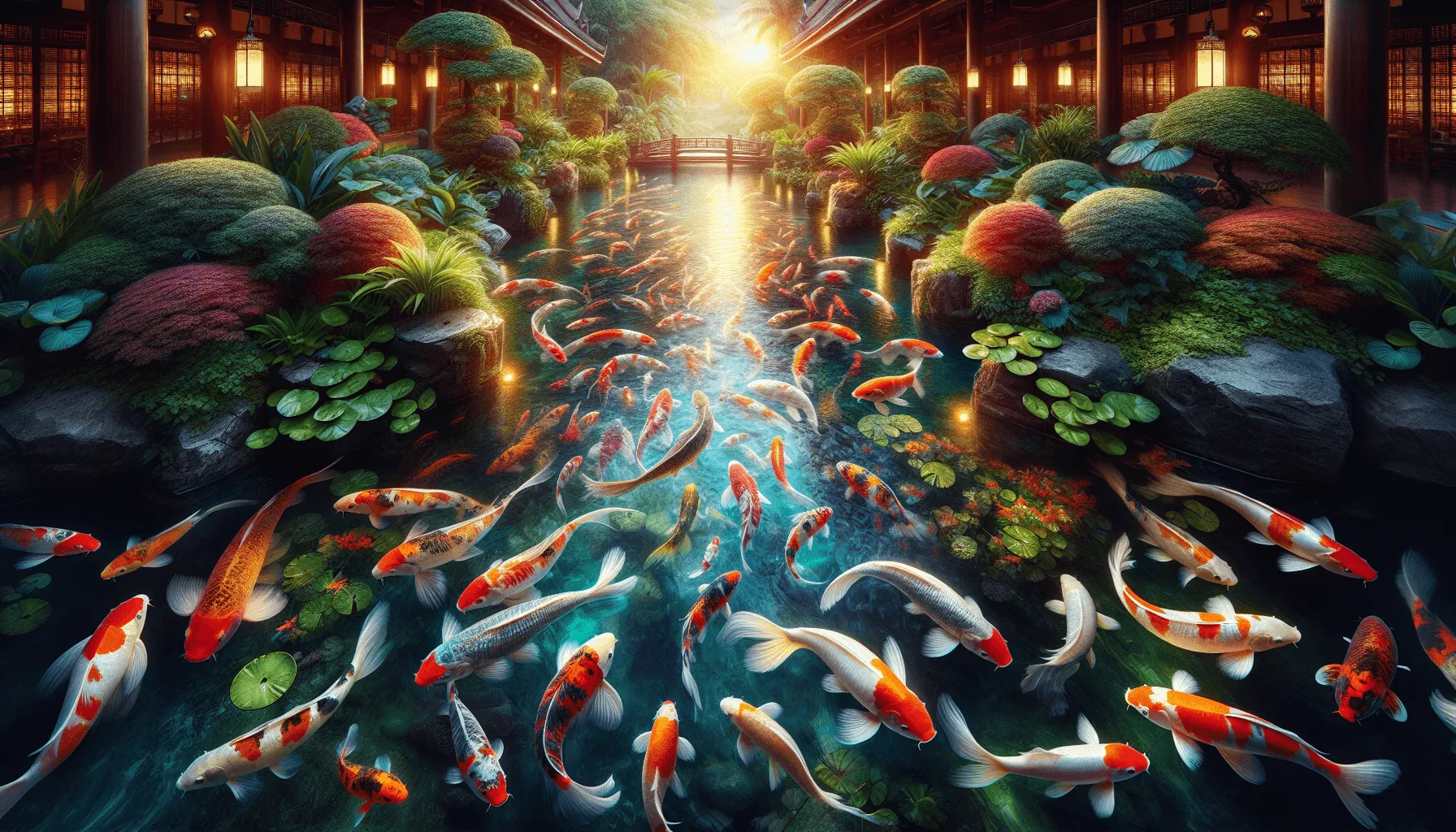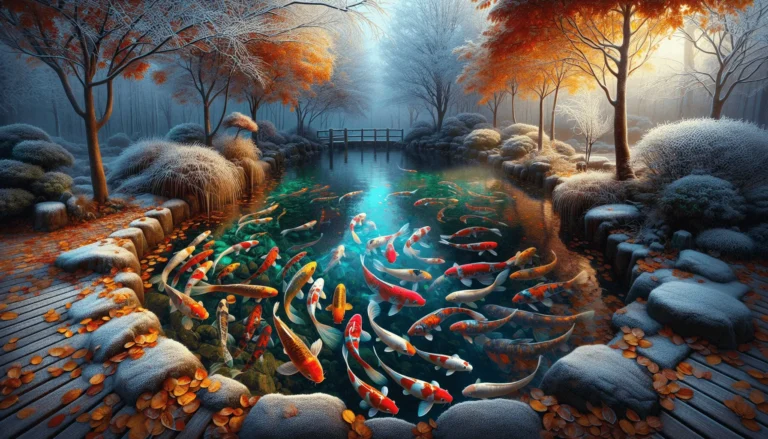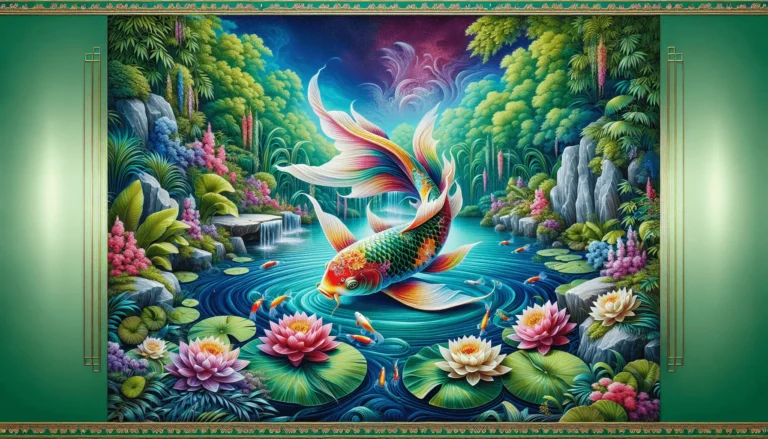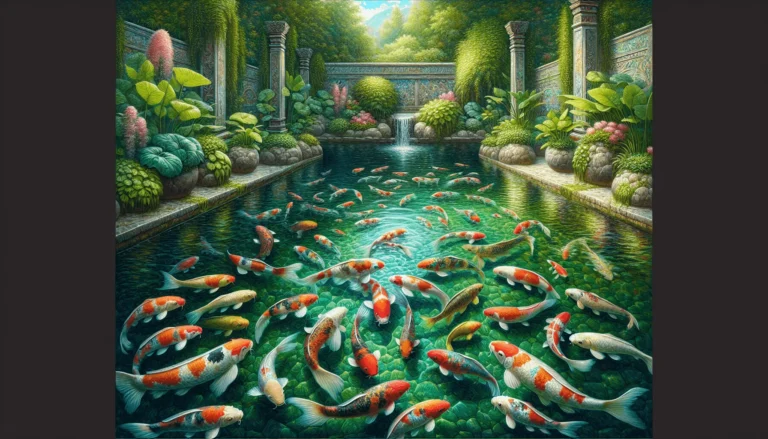Understanding the dietary needs of koi fish is essential for maintaining their health and happiness. This article explores what does koi fish eat by delving into their natural eating habits and offering practical feeding guidelines.
Key Takeaways:
- Koi fish have a diverse diet that includes insects, aquatic plants, seeds, fruits, vegetables, and special treats.
- A well-balanced koi diet ensures robust growth, vibrant colors, and overall vitality.
By knowing what foods koi love to eat and how to feed them properly, you can create an optimal environment for your koi fish to thrive.
Understanding Koi Fish Diet
Koi fish are omnivorous creatures, meaning they consume both plant and animal matter. In their natural habitats, they forage through the pond substrate and water column, eating a variety of food sources. This includes:
- Insects: They often eat insects that land on the water’s surface or reside within it.
- Algae: Grazing on algae helps them fulfill some of their nutritional needs.
- Aquatic Plants: Vegetation like duckweed and water lettuce is part of their regular diet.
- Worms: Earthworms and other worms found in the substrate are common food items.
Understanding the nutritional needs of koi fish is essential for maintaining their health and vitality. A balanced diet ensures they receive all necessary nutrients like proteins, fats, vitamins, and minerals. Proper feeding practices help support growth, enhance coloration, and boost immunity against diseases.
In controlled environments such as ornamental ponds, providing a balanced diet replicates their natural feeding habits. This practice not only keeps them healthy but also prevents malnutrition and associated health issues. Proper diet management contributes significantly to the overall happiness and longevity of your koi fish.
Types of Koi Food
Overview of Various Kinds of Foods Available for Koi
When it comes to feeding your koi, you have a variety of options to choose from. These foods can be broadly categorized into commercial and natural types.
Commercial Koi Food
- Pellets: Available in floating and sinking varieties, pellets are a staple for many koi keepers.
- Freeze-Dried Options: Bloodworms and brine shrimp are popular choices.
- Seasonal Foods: Products like wheat germ pellets are designed for colder months.
Read Also: How to Sell Koi Fish: Pricing, Quality, and Market Tips
Natural Koi Food
- Insects: Brine shrimp, earthworms, and other insects found in their natural habitat.
- Aquatic Plants: Duckweed, water lettuce, and other aquatic vegetation.
- Fruits and Vegetables: Peas, zucchini, watermelon, and more.
Benefits and Drawbacks of Each Type
Commercial Koi Food
Benefits:
- Consistency in nutrition
- Easy to store and feed
- Formulated for specific needs (growth, coloration)
Drawbacks:
- Can be expensive
- Some lower-quality options may contain fillers
Natural Koi Food
Benefits:
- Mimics natural diet
- Often readily available
- Enhances foraging behavior
Drawbacks:
- May lack nutritional balance if used exclusively
- Sourcing can be time-consuming
For a more comprehensive understanding of what koi eat, you might find this article on what do fish eat helpful. Also, if you’re looking for recommendations on the best or healthiest koi food, check out this reddit thread that discusses various options. Lastly, for practical advice on how to effectively feed your koi fish, this guide on feeding koi fish could prove beneficial.
Top 10 Foods That Koi Fish Love to Eat
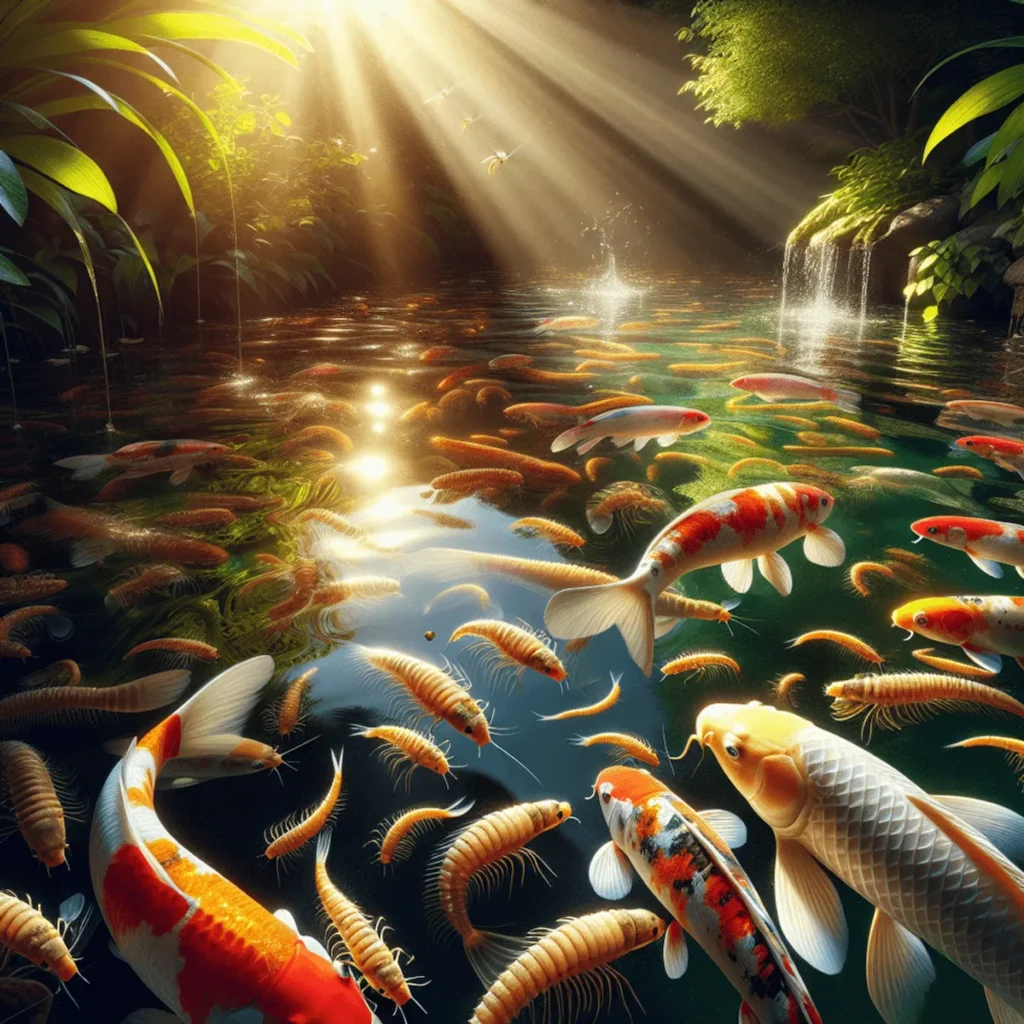
1. Insects Such as Brine Shrimp and Earthworms
Koi fish love insects, which are packed with nutrients essential for their health. Two of the most favored insects in their diet are brine shrimp and earthworms.
Brine Shrimp
These tiny crustaceans are loaded with proteins and highly nutritious. You can easily find them at pet stores, either live or freeze-dried. They’re a great choice for boosting your koi’s growth and energy.
Earthworms
Koi can’t resist earthworms, which are a natural part of their diet and full of protein. You can collect them from your garden, but make sure they haven’t come into contact with any pesticides. Alternatively, you can buy them from bait shops or online stores that specialize in live food.
Including insects like brine shrimp and earthworms in your koi’s diet is more than just a treat; it’s vital for their overall well-being. Make these insects a regular part of their meals to keep them lively and healthy.
2. Aquatic Plants like Duckweed and Water Lettuce
Koi fish naturally love to nibble on different aquatic plants. Duckweed and water lettuce are their favorites because they’re soft and packed with nutrients. These plants also have essential fibers that help with digestion, keeping your koi healthy.
- Duckweed: This small floating plant is high in protein and can be easily found at most garden centers or online stores.
- Water Lettuce: With its lush leaves, water lettuce provides a good mix of vitamins and minerals.
Adding these plants to your koi’s diet gives them variety and supports better digestion.
3. Seeds Found in Water Lilies and Lotus Flowers
Koi fish enjoy munching on seeds found in water lilies and lotus flowers. These seeds are safe for consumption and provide essential nutrients. They offer a good source of protein, healthy fats, and carbohydrates, contributing to the koi’s overall health. When considering what do koi fish eat, incorporating these seeds can add variety to their diet and keep them engaged.
Types of Seeds:
- Water Lily Seeds
- Lotus Flower Seeds
Nutritional Value:
- Protein
- Healthy Fats
- Carbohydrates
4. Fruits and Vegetables Like Peas and Zucchini
Koi fish enjoy a variety of fruits and vegetables, which can be incorporated into their diet for added nutrition. Safe options to consider:
- Peas: High in fiber, they aid digestion. Remove the outer shell before feeding.
- Zucchini: Rich in vitamins, slice into small pieces for easy consumption.
- Watermelon: A hydrating treat during warmer months; offer in moderation.
- Lettuce: Provides essential nutrients, tear into bite-sized pieces.
Avoid high-carbohydrate foods to prevent health issues. These human foods for koi are excellent additions to their diverse diet, providing essential vitamins and minerals.
5. Special Treats Such as Silkworm Pupae and Daphnia Fleas
When considering what do koi fish eat, special treats like silkworm pupae and Daphnia fleas can significantly enhance their diet. These treats are not only highly nutritious but also offer variety to their regular feeding routine.
Silkworm Pupae
Packed with proteins and essential fatty acids, silkworm pupae promote robust growth and vibrant coloration in koi. Offering them once or twice a week keeps your koi excited about feeding time.
Daphnia Fleas
Known for their high nutritional value, Daphnia fleas are an excellent source of protein that helps maintain the overall health of your koi. Feeding these treats occasionally ensures a balanced diet while stimulating natural hunting behaviors.
By incorporating these unique treats, you provide your koi with a diverse and enriching diet that supports their health and vitality.
Feeding Practices for Koi Fish
Recommended Feeding Frequency
Koi fish thrive on a regular feeding schedule that typically ranges from 1 to 4 times a day. Consistency in feeding helps maintain their digestive health and energy levels. However, portion control is crucial to prevent overfeeding, which can lead to water pollution due to uneaten food decomposing in the pond.
- 1–2 times a day: Suitable for casual koi keepers or during cooler weather.
- 3–4 times a day: Ideal for those looking to promote growth and vitality, especially in warmer seasons.
Using an automatic koi fish feeder can help manage this schedule efficiently. These devices ensure that your koi are fed at consistent intervals even when you are not around, reducing the risk of overfeeding.
Seasonal Feeding Guidelines
Koi’s dietary needs change with the seasons. Adjusting their diet based on temperature fluctuations ensures they remain healthy year-round.
Summer Feeding
During the warmer months, koi are more active and have higher metabolic rates. They can be fed up to four times daily with high-protein foods such as:
- Insects (Brine Shrimp, Earthworms)
- Aquatic Plants (Duckweed)
- Special Treats (Silkworm Pupae)
Winter Feeding
As temperatures drop below 50°F (10°C), koi metabolism slows significantly. It is critical to switch to low-protein foods or cut back on feeding entirely to prevent digestive issues.
- Feed sparingly with wheat germ pellets, which are easier to digest.
- Stop feeding when water temperature consistently stays below 40°F (4°C).
Monitoring Health Through Diet
Observing your koi’s behavior and appearance gives insights into their health and dietary needs. Healthy koi typically exhibit vibrant colors, active swimming patterns, and clear eyes.
Signs of a Healthy Diet
- Active Swimming: Indicates good energy levels.
- Bright Colors: Reflects proper nutrition.
- Clear Eyes and Smooth Scales: Sign of overall well-being.
Signs of Dietary Issues
- Lethargy: May indicate overfeeding or poor water quality.
- Dull Colors: Could suggest nutritional deficiencies.
- Bloated Abdomen: Often a sign of overfeeding or inappropriate food types.
Adjusting the diet based on these signs can help mitigate potential health problems. If you notice persistent issues, consulting with an aquatic veterinarian may provide further guidance.
Final Thoughts
Feeding practices play a pivotal role in maintaining the health and happiness of your koi fish. Understanding what does koi fish eat and tailoring their diet throughout the year will ensure they thrive in your pond environment. Regular monitoring and adjustments based on seasonal changes and observed behaviors will contribute significantly to their long-term well-being.
FAQs (Frequently Asked Questions)
What do koi fish eat?
Koi fish are omnivorous creatures and have a diverse diet that includes insects, aquatic plants, seeds, fruits, vegetables, and special treats. Common foods include brine shrimp, earthworms, duckweed, water lettuce, and human food like peas and zucchini.
How often should I feed my koi fish?
Koi fish should be fed 1 to 4 times a day. It’s essential to control portions to prevent overfeeding. During different seasons, their feeding frequency and the type of food may need to be adjusted.
What types of food are best for koi fish?
There are various types of koi food available, including commercial pellets and natural options like insects and aquatic plants. Each type has its benefits and drawbacks; commercial foods often provide balanced nutrition while natural foods can enhance variety in their diet.
Can koi fish eat fruits and vegetables?
Yes, koi can safely eat certain fruits and vegetables. Recommended options include peas and zucchini. It’s important to offer these in moderation to ensure a balanced diet.
What are some special treats I can give my koi fish?
Special treats such as silkworm pupae and Daphnia fleas can be offered to koi fish. These unique treats can enhance their diet but should be given occasionally rather than as a staple.
How can I tell if my koi fish are healthy based on their diet?
Monitoring your koi’s health through their diet involves observing their behavior and appearance. Signs of a healthy diet include active swimming, vibrant colors, and clear eyes. Conversely, lethargy or discoloration may indicate dietary issues that require adjustments.

